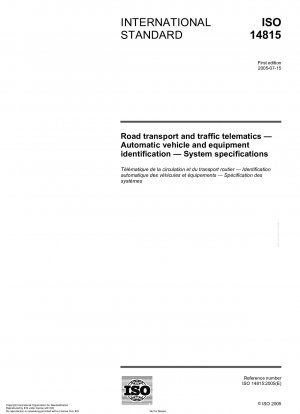ISO 14815:2005
Road transport and traffic telematics - Automatic vehicle and equipment identification - System specifications
- Standard No.
- ISO 14815:2005
- Release Date
- 2005
- Published By
- International Organization for Standardization (ISO)
- Latest
- ISO 14815:2005
- Scope
- This International Standard defines a generic AVI/AEI System specification for nominal AVI/AEI to provide an enabling International Standard, which, whilst allowing the system specifier to determine the performance levels and operating conditions, provides a framework for nominal interoperability. Within the road context of the Transport and Traffic Telematics Sector, AVI and AEI systems have the specific objective of achieving a unique or unambiguous positive identification of a vehicle or item of equipment, and to make that identification automatically. Whilst AVI may also be seen as an essential component of some applications, the particular needs of such systems are outside the scope of this International Standard. As far as is possible, care is still taken to provide a useful tool for such applications. This International Standard only refers to AVI/AEI in the road environment. Multimodal and intermodal exchanges of AVI/AEI are outside the scope of this International Standard. Where AVI/AEI applications are part of a larger system, and where no standardized application-specific test requirements exist, these test requirements apply. Anonymity and privacy issues are discussed in ISO 14816, and are not handled in this International Standard. This International Standard is designed for system specification that will enable a nominal interoperability based on a DSRC link. AVI/AEI systems that are relying on other link types are outside the scope of this International Standard for those parameters where the link type influences parameters. The scope of this International Standard is confined to generic AVI/AEI system specification for systems that have the following "core" components: — A means of communication between the vehicle/equipment and the reading station (e.g. a DSRC link); — operation within a reference architecture which enables compatible systems to read and interpret the identification (See ISO TR 14814); — compliance to commonly understood data structures that enable meaningful interpretation of the data exchanged in the identification sequence (See ISO 14816); — the provision of operating and environmental parameters (or classes of operating parameters) within which such systems must successfully function without impairing interoperability. This is to ensure that the system specifier can state his requirements clearly to Implementation Designers and Integrators, and measure the performance of such systems (covered in this International Standard).
ISO 14815:2005 Referenced Document
- ISO 14816 Road transport and traffic telematics — Automatic vehicle and equipment identification — Numbering and data structure AMENDMENT 1
- ISO 7637-1:1990 Road vehicles; electrical disturbance by conduction and coupling; part 1: passenger cars and light commercial vehicles with nominal 12 V supply voltage; electrical transient conduction along supply lines only
- ISO/IEC 8825-2 Information technology -- ASN.1 encoding rules-- Part 2:Specification of Packed Encoding Rules (PER)*, 2021-06-30 Update
ISO 14815:2005 history
- 2005 ISO 14815:2005 Road transport and traffic telematics - Automatic vehicle and equipment identification - System specifications
